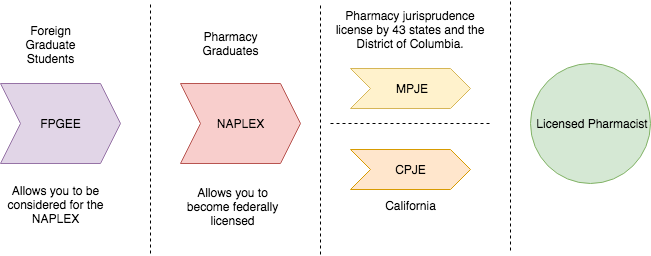To practice as a licensed pharmacist in California you must first pass two exams. The first is the national, North American Pharmacist Licensure Exam (NAPLEX); after this, the second exam is the California Pharmacist Licensure Exam (CPJE). Both must be passed before a pharmacy graduate can practise as one of the 40,000+ licensed pharmacists in the State of California.
In addition, if you are a foreign graduate in pharmacy, you will need to take the Foreign Graduate Exam (FPGEE) before all of these exams, adding one more step to the above process.

The CPJE mainly tests pharmacy graduates on California Practice Standards. In addition, key points about the exam include:
|
|---|
Structure of the CPJE Exam
There are 90 multiple-choice questions that you are presented with during the exam, however, 75 of the 90 are deemed "real" questions (20 + 33 + 22). There are 15 additional questions that don't actually affect your score. The breakdown of the questions is as follows:
Patient Medications (20 items)
- Collect, organize, and evaluate information
- Dispense medications
Patient Outcomes (33 items)
- Determine a course of action
- Educate patients and health care professionals
- Promote public health
Pharmacy Operations (22 items)
- Pharmaceuticals, Devices and supplies, and Inventory control
- Perform quality assurance/improvement
- Manage operations, human resources, and information systems
- Manage formulary and medication use systems
For a more in-depth look at what you need to know for the CPJE have a look at our CPJE syllabus article.
We provide up-to-date, guaranteed courses for students who want to pass the California Pharmacy Jurisprudence Exam on their first attempt. We have worked with over 1,000 pharmacists, who have passed the CPJE Exam in previous years to try to refine our resources and CPJE practice questions to what you really need to know for the CPJE. So why not try our Free CPJE Exam Questions updated to the new CPJE requirements.
